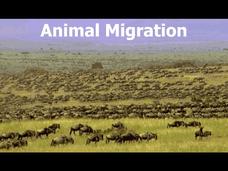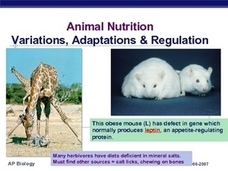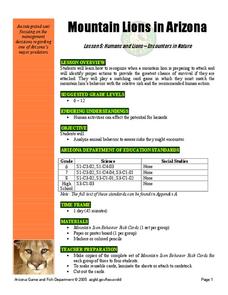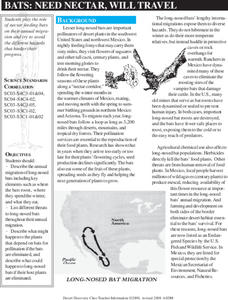Adaptation Teacher Resources
Find Adaptation lesson plans and worksheets
Showing 284 resources
Lesson Planet Curated
Unit Two: A Serious Economics Nut
The second unit in the series examines the complex relationships between animals and plants in the whitebark pine community of Waterton-Glacier International Peace Park. In the first of five lessons, scholars mimic Clark’s Nutcracker...
Lesson Planet Curated
Activity Book: Discover Your Changing World With NOAA
Introduce middle schoolers to the essential principles of climate science with a collection of 10 activities. Class members learn about the Earth’s climate systems, factors that change these systems, and the impacts of those changes....
Curated OER
Human PreHistory 101: Prologue
The Khan Academy displays an animated and narrated clip about human prehistory and the relationships between us and our ancestors. The formal narration is balanced by the hand-drawn animation, making an attraction that is sure to hold...
Curated OER
Adaptations
Cacti have special adaptations for living in desert heat and dryness. Polar bears have adaptations that allow them to withstand icy conditions. Humans adapt to different conditions by wearing appropriate clothing or building homes...
Curated OER
Interdependence and Adaptation
Find out how camels and polar bears are each perfectly suited to their environments because of their physical adaptations. Several key features of each animal are discussed along with how those features work in their specific...
TED-Ed
Can Wildlife Adapt to Climate Change?
Can humans protect other species from the effects of climate change? Can animals adapt or evolve fast enough to survive? Check out this video for some surprising answers.
University of Washington
Animal Migration
Here is a unique resource to use with middle and high schoolers that deals with animal migration. Viewers discover the reasons for, types of, and animals that practice this behavioral adaptation. Specific animals that are introduced...
Howard Hughes Medical Institute
Recent Adaptations in Humans
You've probably spent plenty of time discussing animal adaptations with your young biologists, but what about human adaptations? Explore the evolving traits of humankind through an interactive that combines text and video clips. Scholars...
Curated OER
Animal Nutrition - Variations, Adaptations, & Regulation
Colorful pictures and graphics make this a visually-appealing presentation on animal nutrition. Be aware that two of the sixteen slides include blank graphic organizers, so you will need to find the other existing version of this...
TED-Ed
Poison vs. Venom: What's the Difference?
Did you know that poison and venom are not the same? Both are toxic, but poison must be inhaled, ingested, or absorbed, while venom must be injected into a wound. The narrator explains that some toxic compounds may be used for good, as...
TED-Ed
Climate Change: Earth's Giant Game of Tetris
In this colorful animation, our current problem with climate change is likened to a block-stacking game of Tetris. Greenhouse gases are increasing in the atmosphere at an increasing rate. Can we place them properly before it's too late?...
TED-Ed
How Whales Breathe, Communicate... and Fart with Their Faces
Dr. Joy Reidenberg is an expert in comparative anatomy, but also quite relatable to preteens! Here, she lectures on echolocation by likening it to "farting with the face!" She explains with film, actual whale voice recordings, diagrams,...
PBS
When Humans Were Prey
A quarry worker in southern Africa discovered the first fossil evidence that the human species originated on the continent less than 100 years ago! Evidence from the specimen indicates the first humans were not the hunters—but the prey....
Aquarium of the Pacific
Amazing Adaptations
We can all adapt. Classmates watch a video about the adaptations of sea horses that allow them to eat and move. They then watch penguins on webcams to see what adaptations help the penguins find food, move, and avoid predators. Finally,...
TED-Ed
How Do Viruses Jump from Animals to Humans?
Can humans be infected by animal viruses? Pupils explore the phenomenon of viral evolution and learn about how animal viruses sometimes adapt to infect humans. They see how viruses are transmitted and what pathogens need to survive. The...
Curated OER
The Great Animal Systems Challenge!
Advanced placement biology aces list systems that have evolved over time, adaptations, and structure-function relationships. The resource requires plenty of writing to answer these questions, so allow a few days for them to complete the...
Curated OER
Mountain Lions in Arizona Lesson 5: Humans and Lions - Encounters in Nature
Fledgling felinologists are taught how to recognize when a mountain lion is preparing to attack. They identify proper actions to provide the greatest chance of survival if they are attacked. Learners play a matching card game in which...
TED-Ed
Inside the Minds of Animals
Is it instinct and intelligence that divide animals from humans? What are they really thinking, and how do we define that? Check out this great video that discusses everything from Descartes' thoughts on the topic and Darwinian evolution...
National Gardening Association
Migration Mishaps
Elementary ecologists pretend to be migratory hummingbirds. They fly between wintering and nesting grounds, trying to reach a habitat haven. In a musical-chair fashion, some birds will miss out, and are removed from the game. To further...
Chicago Botanic Garden
Migration, Adaptation, and Changing Climates
It is easy for humans to adapt to changing environments, but how do animals and plants do it? Classes discuss how plants and animals deal with environmental changes in the second of seven lessons. Through questions and discussions,...
Prince William Network
Migration Headache
During this game, kids become migratory shorebirds and fly among wintering, nesting, and stopover habitats. If they do not arrive at a suitable habitat on time, they do not survive. Catastrophic events are periodically introduced that...
Curated OER
The Art of Adaptation
Students examine and discuss animal adaptation. They read an article about snakes, conduct research on ways animals adapt, develop a diagram, and write a short story written from the perspective of the animal they researched.
Curated OER
Bats: Need Nectar, Will Travel
Beginning wildlife biologists become adult bats, baby bats, snakes, owls, bobcats, or land-clearing developers in a grand role-playing activity. In a large open space, they play a game in which they move to designated areas based on what...
TED-Ed
Meet the Tardigrade, the Toughest Animal on Earth
The toughest animal on Earth is also one of the smallest creatures on Earth. Watch a video about the tardigrade and its ability to withstand many stressors, including lack of water and freezing temperatures.

























